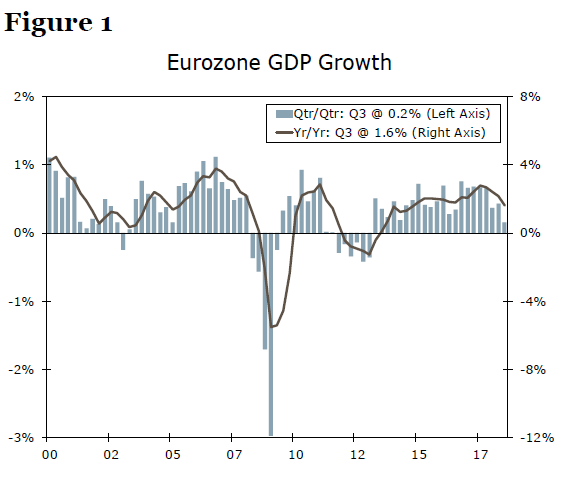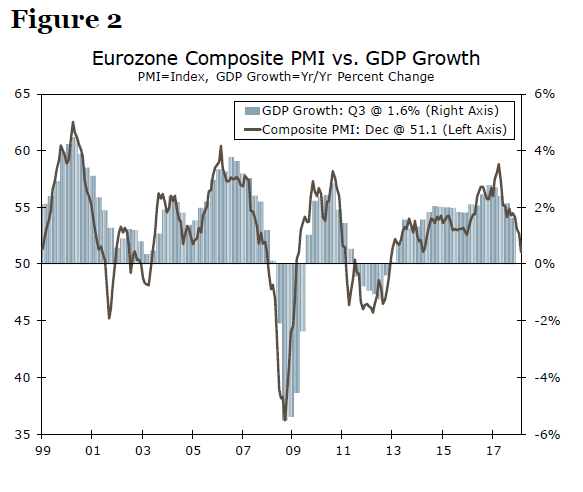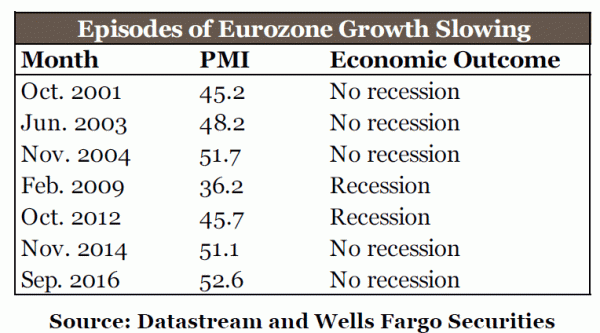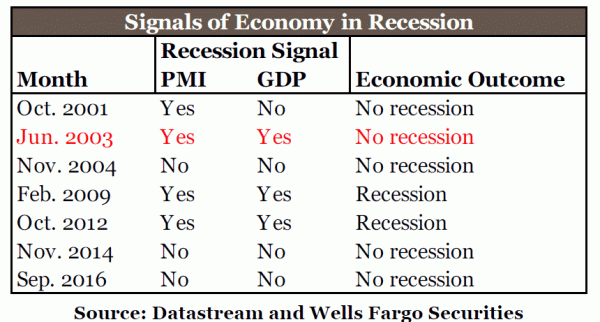Executive Summary
The recent slowdown in Eurozone economic growth has sparked fears that the bloc may be approaching, or already in, a recession. Forecasting recessions is a notoriously difficult task, and even defining what marks a recession is not always straightforward. In this report, we identify a couple simple rules of thumb that may allow readers to monitor the economic data for signs of an imminent recession in the Eurozone. While some recent indicator readings are worrying, we do not believe the data at present suggest a Eurozone recession is either imminent or inevitable.
Draghi Acknowledges Economic Disappointments
European Central Bank (ECB) President Mario Draghi spoke to the European Parliament last week and, as part of that speech, provided his latest assessment of the Eurozone economy. Among his comments, Draghi said consumption and investment are still expanding and that the labor market remains strong. He added that economic expansion is happening at slower and slower growth rates and that significant monetary stimulus is still needed, but nonetheless stated that the European economy is not heading to a recession. Clearly the prolonged period of slow growth is attracting the attention of ECB policymakers. A natural question to ask is “how close is the Eurozone to recession?” – the answer to which could have significant implications for Eurozone financial markets and ECB monetary policy.
How Can We Tell If a Recession Is Taking Place?
Of course, to know if we are in an economic recession or heading in that direction, it is important to understand what a recession looks like and how to determine if it is taking place. For the United States, an official recession, as defined by National Bureau of Economic Research (NBER), is:
“a significant decline in economic activity spread across the economy, lasting more than a few months, normally visible in real GDP, real income, employment, industrial production, and wholesale-retail sales.”
In terms of identifying a recession, there are essentially two differing approaches. The first is to simply monitor the contemporaneous or recently released economic figures, and assess whether the data are suggestive of an economy that is in contraction. For example, a “shorthand” definition of a recession is often considered to be two consecutive quarters of a decline in real GDP.
A second and less timely approach to identifying and determining recession is to rely on an “official” arbiter of the economic or business cycle. In the United States, for example, this role is fulfilled by the NBER. Meanwhile, acknowledging that there is a shorter history of business cycle dating in Europe, the Center for Economic Policy Research (CEPR) fulfills a broadly similar task for the Eurozone economy. Determining recessions via an “official” arbiter is a less timely approach, simply because these institutions assess a broader range of economic indicators and await potential revisions to economic data before determining that the economy has started contracting. Because of this, it can be several months or quarters later before there is an official declaration that a recession has either started or ended.
Eurozone Recessions: Five Since 1970
For the Eurozone economy as a whole, economic recessions have been reasonably infrequent. The CEPR has determined that since 1970 there have been five region-wide recessions. Our primary interest for the purposes of this report are the two most recent Eurozone recessions that occurred around 2008-2009 and 2011-2013, periods for which relatively high quality, high frequency economic data for the aggregate Eurozone economy are available.
The CEPR dates Eurozone recessions by quarter, and has determined that the past two Eurozone economic recessions took place from Q2 2008 to Q2 2009, and from Q4 2011 to Q1 2013. The 2008- 2009 recession was particularly sharp and severe, occurring around the time of the global financial crisis. Thus, for the purposes of our analysis, it may be the latter 2011-2013 recession that is more instructive in assessing just how close we might be to a Eurozone recession
Perspective One: The Pace of GDP Growth
One approach is to monitor whether GDP growth slowed below a certain speed, and for how long, prior to the Eurozone falling into recession. Analogous to a bicycle needing to maintain a certain amount of forward momentum to avoid falling over, the idea is that the economy needs to maintain a certain degree of forward momentum to avoid falling into recession. Just ahead of the recession that began in late 2011, the second and third quarters registered zero growth, an outcome that was consistent with the economy subsequently falling into recession. There were, however, other periods of particularly slow growth since 2000 where despite that slow growth the Eurozone economy was able to avoid recession (Figure 1). We detail those episodes below:
- Q3 2004-Q1 2005: cumulative 0.9% growth over three quarters, with all three quarters positive.
- Q4 2002-Q2 2003: cumulative 0.1% growth over three quarters, with two of those three quarters positive. Arguably it was this episode that was closest to providing a “false signal” of an impending recession.
- Q2 2001-Q1 2002: cumulative 0.6% growth over four quarters, with all four quarters positive.
To summarize then, two quarters of zero growth in 2011 was shortly thereafter followed by a Eurozone recession, while an average quarterly growth pace of 0.15% to 0.30% over three to four quarters was “strong” enough for the economy to avoid falling into recession. Expanding on the bicycle analogy and referring specifically to the Q4 2002-Q2 2003 period, we note that a meager pace of forward progress does not guarantee a bicycle will fall over, but it certainly makes the rider more susceptible to an uneven road surface or an unexpected wind gust. In a similar fashion, once economic growth slows below a certain speed, the economy likely becomes more susceptible to unexpected shocks. Taking that into account, we believe a reasonable rule of thumb is that an average growth pace of 0.15% for as long as three to four quarters is perhaps still strong enough for the Eurozone economy to avoid recession, but a drop below that pace could be a signal of an impending recession.
Perspective Two: Monitoring Timely Survey Data
Another constructive approach, in our opinion, is to monitor the timely Purchasing Managers Indices (PMI) data for signs of an approaching recession (PMI data are available since the late 1990s). Figure 2 compares lows in the composite PMI for the entire economy (that is, both the manufacturing and service sectors) relative to Eurozone GDP growth. Theoretically, PMI readings above 50 indicate economic expansion, while readings below 50 indicate economic contraction. Overall, movements in the PMI offer good guidance on trends in GDP, although the relationship is not perfect. For example, there were a couple of instances in the early part of the last decade where the PMI fell below 50, but the Eurozone economy did not fall into an official recession.
Once again utilizing our bicycle analogy, our question becomes whether there is a certain level of forward economic momentum that is needed to avoid falling into recession. In this case, we view the equivalent question as ‘is there a certain level of the PMI below which we should be worried about an increased risk about a Eurozone recession?”
Over the past two decades, there are several instances in the Eurozone of slowing growth and a falling PMI. In a few instances, the PMI stabilized and recovered above the 50 level (i.e. consistent with expansion). Moreover, in those instances GDP growth firmed and the expansion continued. In some other cases the PMI fell below the 50 level (i.e. consistent with contraction) and in some— but not all—of the instances the economy fell into recession. A couple of times there were arguably special factors—proverbial bumps on the road—that may have exacerbated declines and led to depressed readings. For example, the October 2001 low in the PMI occurred immediately in the wake of the September 11 terrorist attacks, while the June 2003 low occurred at the onset of the U.S. military invasion of Iraq, which happened in late March of that year. In any case, all of episodes above are detailed in the immediately following table:
Looking first at the episodes where the PMI declined meaningfully but ultimately stabilized in expansion territory above 50, the PMI reached lows in November 2004, November 2014 and September 2016. The lowest of three troughs was 51.1 in 2014 which, in our view, suggests some evidence the PMI can stabilize and recover so long as the PMI stays above 51.0. Put another way, PMI readings above 51.0 were consistent with an economy that ultimately avoided recession. That said, the 51.0 level could also arguably be viewed as one in which the economy is teetering on the edge. In every other instance where the PMI fell below 51.0 it ultimately bottomed clearly in contraction territory. In essence, the risk of recession arguably increases once the PMI falls to 51.0 or below, and thus a potential rule of thumb is that a decline (or a trough) in the composite PMI below 51.0 could be a signal of an impending recession, whereas a stabilization above 51.0 suggests a recession could be avoided.
Warning Lights Flashing Yellow, Not Red
Taking things a step further, we combine each of the recession signals (the level of the composite PMI and trailing GDP growth) to assess whether the Eurozone economy is close to recession now. The idea here is that the strongest signal of a potential recession, or that we are close to recession, is when both of these indicators/signals are pointing to that outcome. Examining the episodes we described earlier, the table below highlights whether there was an overall signal of, or confirmation that the economy was already in, recession.
In only one instance (June 2003) was there a false signal, where both the level of the PMI and trailing GDP growth were signaling an impending recession that never occurred. Thus, while assessing how close the Eurozone is to economic recession is clearly part art and part science, our findings suggest that our rules of thumb have done a reasonable job in signaling whether a recession is approaching or not. What then are the implications for the current episode? Like ECB President Draghi, we do not (yet) believe these important economic indicators are signaling an approaching Eurozone recession. GDP growth has averaged 0.33% per quarter over the past three quarters, a pace that has been consistent with the Eurozone avoiding recession in the past (Q3 2004-Q1 2005 and Q2 2001 to Q1 2002). Similarly, the December 2018 PMI of 51.1 is not yet at a level that would more clearly and consistently signal an approaching economic downturn, although it is close. Accordingly, while some recent indicators are worrying, we do not believe a Eurozone recession is imminent or inevitable. In our view, GDP growth would need to range between 0.1%-0.2% (or slower) per quarter for three or more quarters AND the composite PMI would have to remain at or below the 51.0 level for several months before we would become seriously concerned that the Eurozone is either imminently approaching, or in, economic recession
















